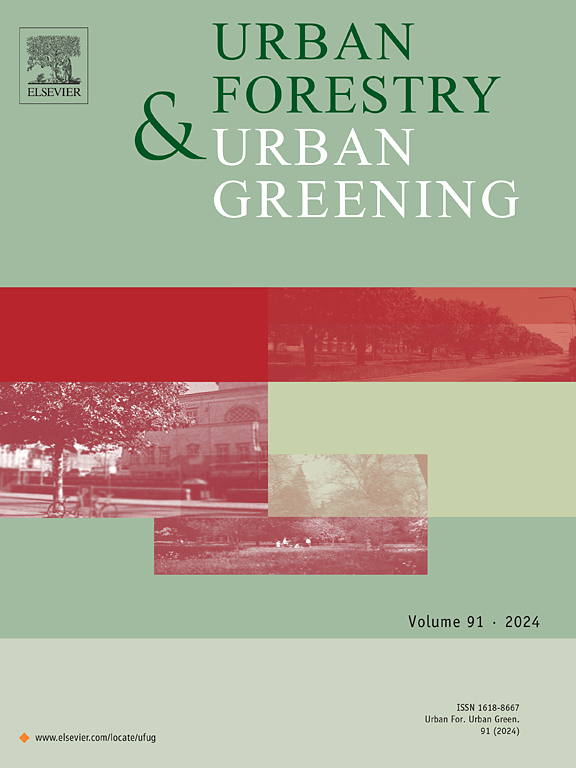加州各社区的城市森林覆盖率和生态系统服务对火灾的反应各不相同
IF 6
2区 环境科学与生态学
Q1 ENVIRONMENTAL STUDIES
引用次数: 0
摘要
野火引发的城市火灾是一种新出现的极端事件,影响着全球的社区和城市森林。然而,大部分有关火灾对城市生态系统影响的文献主要集中在野地-城市交界(WUI)地区、建筑物损失的相关性、风险缓解以及野地植被和燃料方面。美国加利福尼亚州最近发生的三场城市火灾为我们提供了一个探索这些火灾对城市森林影响的机会:2017 年 Tubbs(圣罗莎)和 Thomas(文图拉)大火以及 2018 年烧毁天堂的 Camp 大火。因此,我们使用哨兵和激光雷达数据(10 米分辨率)分析了火灾前后 5 年内邻里级城市树木覆盖(nUTC)的变化。然后,我们探讨了火灾严重程度对几种调节生态系统服务(如碳、空气污染、雨水)变化的影响。从 "野火后植被状况快速评估 "过程和其他地理空间数据集得出的结果表明,火灾影响是分散的,街区内的火灾严重程度从未燃烧到极端严重不等。我们发现,火灾发生 5 年后,与邻近未受火灾影响的社区相比,文图拉和圣罗莎的 nUTC 正在恢复到火灾前的水平,而天堂镇的 nUTC 则随着时间的推移持续减少。文图拉和圣罗莎有 20-25% 的火灾影响区域位于既定的 WUI 边界之外。然而,当地规模的城市树木覆盖率和生态系统服务供应是滞后的,恢复时间取决于周围的生物群落和社会生态环境。在内陆海拔较高的社区(如天堂镇),nUTC 和相关生态系统服务的恢复可能需要更长的时间。我们的研究为评估受城市野火影响的树木覆盖和生态系统服务的跨时空响应提供了路线图。这也是首次评估火灾对 WUI 边界以外的城市生态系统和社区影响的研究之一,目前全球范围内的野火威胁都在增加。本文章由计算机程序翻译,如有差异,请以英文原文为准。
Urban forest cover and ecosystem service response to fire varies across California communities
Urban fires that result from wildfires are an emerging, extreme event affecting communities and urban forests globally. However, much of the fire effects on urban ecosystems literature is primarily focused on Wildland-Urban Interface (WUI) areas, correlates of building loss, risk mitigation, and wildland vegetation and fuels. Three recent urban fires in California USA provided an opportunity to explore these effects on urban forests: the 2017 Tubbs (Santa Rosa) and Thomas (Ventura) fires and the 2018 Camp fire that burned Paradise. Accordingly, we analyzed pre- and post-fire neighborhood level urban tree cover (nUTC) change over 5 years using Sentinel and LiDAR data (10 m resolution). Then, we explored the effects of fire severity on changes in several regulating ecosystem services (e.g., carbon, air pollution, stormwater). Findings from the Rapid Assessment of Vegetation Condition after Wildfire severity processes and other geospatial datasets show that fire effects were patchy with fire severity within neighborhoods ranging from unburned to extreme. We found that ∼5 years after the fires, and relative to adjacent non-fire affected neighborhoods, Ventura and Santa Rosa’s nUTC is recovering to pre-fire levels while Paradise’s nUTC is being consistently lost over time. Ventura and Santa Rosa had 20–25 % of their fire affected area outside established WUI boundaries. However, local-scale urban tree cover and ecosystem service supply are lagged, and recovery time depends on the surrounding biome and socio-ecological context. In inland, higher elevation communities – like Paradise – the recovery of nUTC and the associated ecosystem services might materialize over a much longer timeframe. Our study provides a roadmap to assess the response of urban wildfire-affected tree cover and ecosystem services across space and time. It is also one of the first assessments of fire effects on urban ecosystems and communities outside of WUI boundaries that are now experiencing increased threat from wildfires globally.
求助全文
通过发布文献求助,成功后即可免费获取论文全文。
去求助
来源期刊

Urban Forestry & Urban Greening
FORESTRY-
CiteScore
11.70
自引率
12.50%
发文量
289
审稿时长
70 days
期刊介绍:
Urban Forestry and Urban Greening is a refereed, international journal aimed at presenting high-quality research with urban and peri-urban woody and non-woody vegetation and its use, planning, design, establishment and management as its main topics. Urban Forestry and Urban Greening concentrates on all tree-dominated (as joint together in the urban forest) as well as other green resources in and around urban areas, such as woodlands, public and private urban parks and gardens, urban nature areas, street tree and square plantations, botanical gardens and cemeteries.
The journal welcomes basic and applied research papers, as well as review papers and short communications. Contributions should focus on one or more of the following aspects:
-Form and functions of urban forests and other vegetation, including aspects of urban ecology.
-Policy-making, planning and design related to urban forests and other vegetation.
-Selection and establishment of tree resources and other vegetation for urban environments.
-Management of urban forests and other vegetation.
Original contributions of a high academic standard are invited from a wide range of disciplines and fields, including forestry, biology, horticulture, arboriculture, landscape ecology, pathology, soil science, hydrology, landscape architecture, landscape planning, urban planning and design, economics, sociology, environmental psychology, public health, and education.
 求助内容:
求助内容: 应助结果提醒方式:
应助结果提醒方式:


